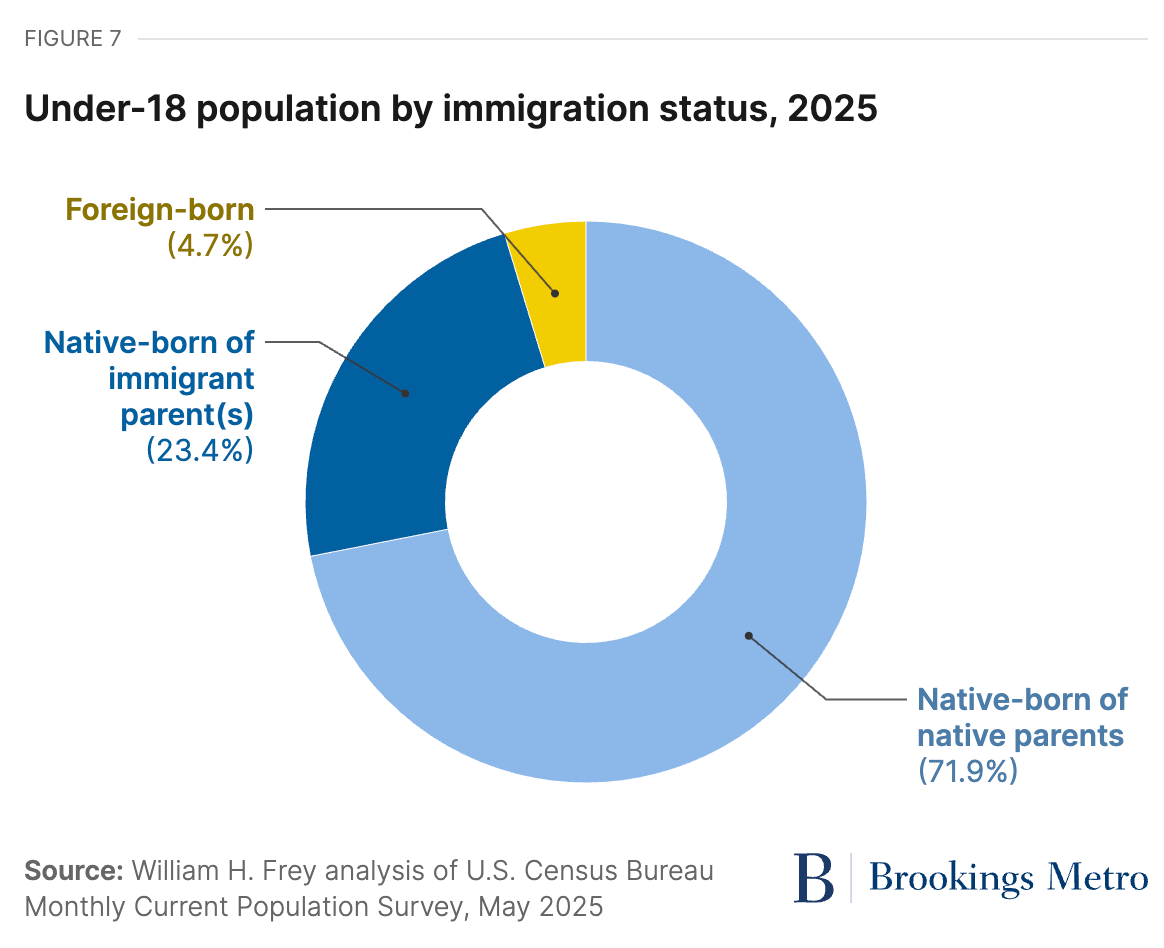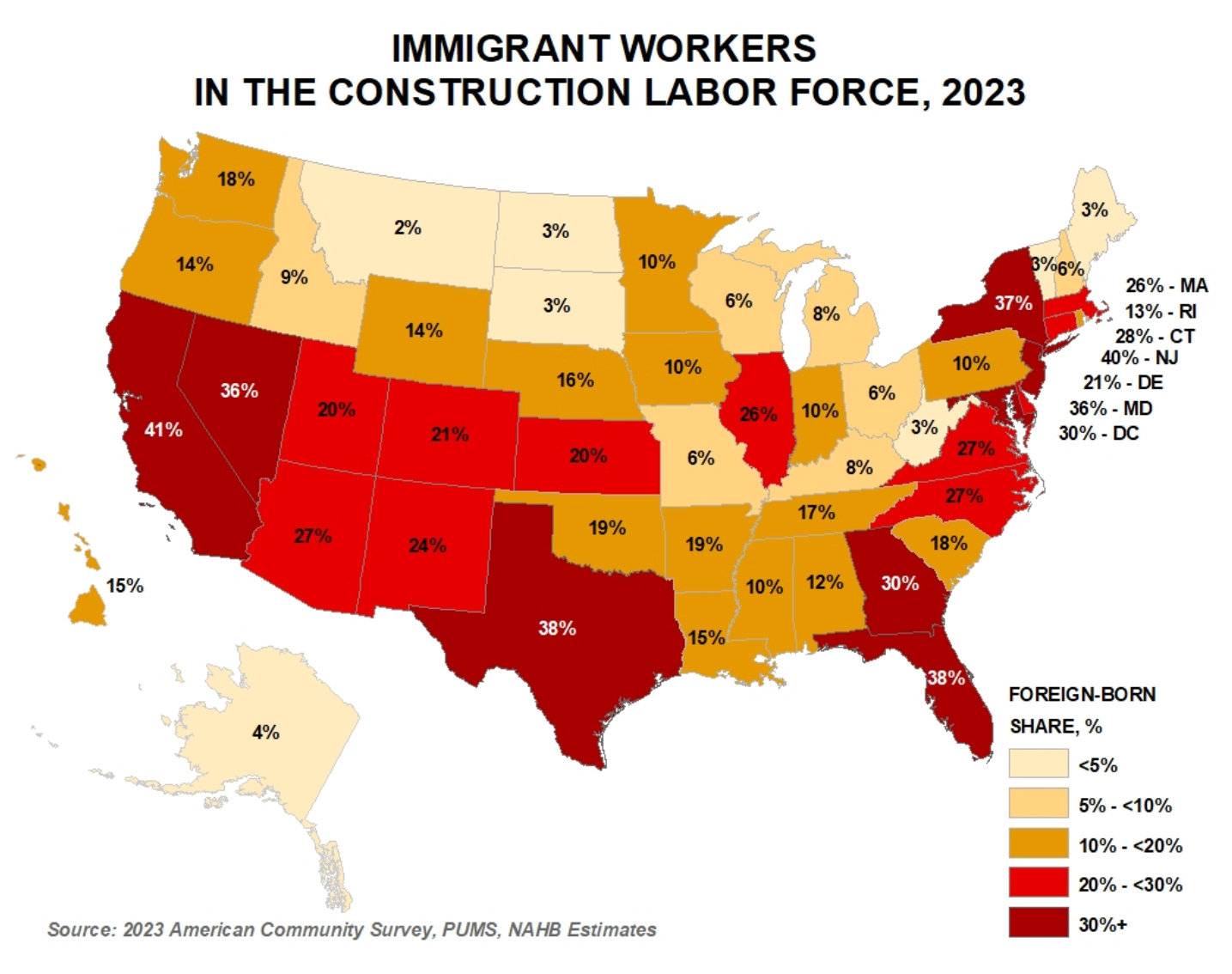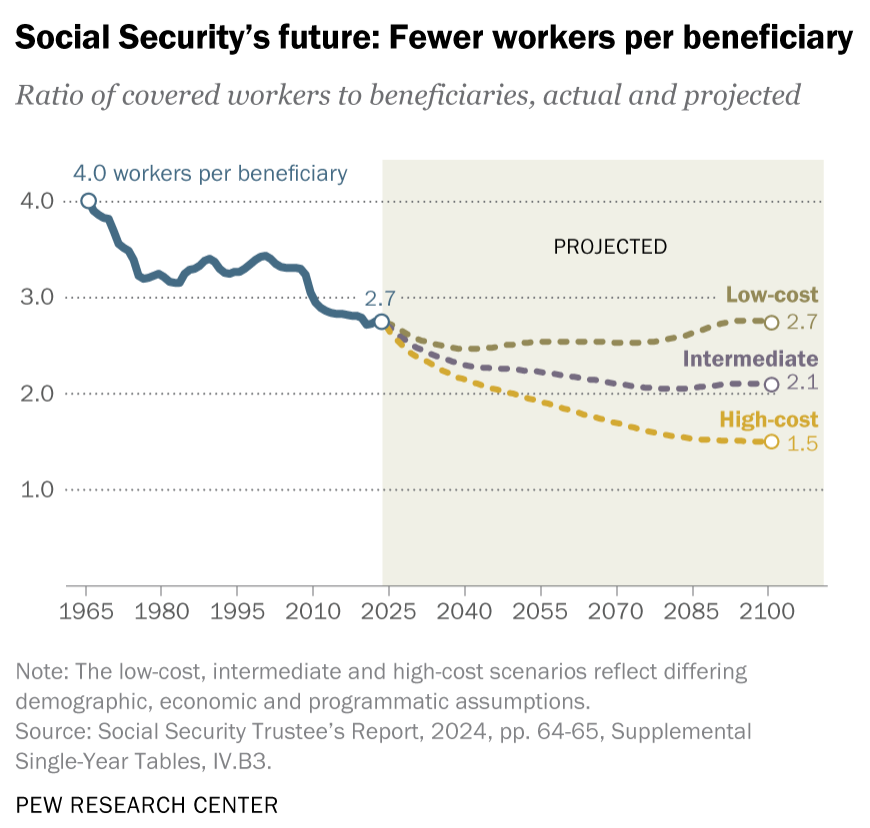The US Population Could Shrink in 2025, For the First Time Ever
It's a story with massive economic and political significance. But it's receiving strangely little attention.

The United States is on the precipice of a historic, if dubious, achievement. If current trends hold, 2025 could be the first year on record in which the US population actually shrinks.
The math is straightforward. Population growth has two sources: natural increase (births minus deaths) and net immigration (arrivals minus departures). Last year, births outnumbered deaths by 519,000 people. That means any decline in net immigration in excess of half a million could push the U.S. into population decline. A recent analysis of Census data by the Pew Research Center found that between January and June, the US foreign-born population fell for the first time in decades by more than one million. While some economists have questioned the report, a separate analysis by the American Enterprise Institute predicted that net migration in 2025 could be as low as negative 525,000. In either case, annual population growth this year could easily turn negative.
This would be a historic first. For nearly 250 years, America has only known growth. According to our best estimates, the nation’s population expanded throughout the Civil War, despite the deaths of more than 700,000 Americans. It grew throughout the Spanish Flu1, both World Wars, and countless bloody entanglements with other countries. Even COVID, which killed more than a million Americans, didn’t reverse the trend. But Trump’s immigration crackdown may accomplish what no war, plague, or calamity has ever done.
“It’s certainly possible,” said William Frey, a renowned demographer and a senior fellow at the Brookings Institution. “My bet at the beginning of 2025 was that growth would be positive but very slow. But it’s certainly possible that the population could shrink this year.”
Frey’s own projections had put the first years of shrinking America somewhere in the 2080s, around my 100th birthday. If the fall began in the 2020s, it could mean pulling forward demographic decline by more than half a century.
Two Stories About Shrinking America
There are two ways to see the story of plunging immigration.
Trump and his allies will prefer something like this version: Under Joe Biden, annual net immigration smashed all-time records, led by an uncontrolled and unsustainable surge of migrants seeking asylum. Seen this way, today’s decline is just a whiplash after a historic surge. Perhaps, one might argue, the country added so many foreign-born people in the last few years that a short-term correction is necessary.
This is not my preferred interpretation. Biden’s permissive border policies were politically disastrous and costly for cities straining to house migrants. But they also fueled growth. Strong immigration helped power the U.S. economy ahead of other rich countries after the pandemic.
Trump, by contrast, has gone far beyond restricting illegal entry. He has used the specter of undocumented immigration to build out a paramilitary force to carry out deportations of dubious legality; to frighten migrants who are here lawfully; to demolish our refugee programs; to constrict overall migration into the U.S. in the long run; to intimidate colleges that accept large numbers of foreign-born students; and to generally obliterate America’s privilege as the country where the world’s smartest people want to study, work, and live. The result is not just tighter borders. It’s a deliberate policy of demographic contraction that could wreak havoc across the US economy.
The Economics of Emptying America
Trump won the 2024 election due to a cost-of-living backlash. But zero immigration can easily become stagflationary. A smaller workforce means lower output (stagnation) while labor shortages can push up wages and prices in the short term (inflation).
The first impact would be generational. “Immigrants tend to be much younger than the rest of the US population,” Frey told me. Nearly one-quarter of today's under-18 population is native-born with immigrant parents, and another 5 percent are foreign-born children. In a negative-immigration world, the under-18 population would quickly fall.
Soon after, the workforce itself would contract. A stagnant or shrinking labor force isn’t an acute shock. It’s like a chronic disease with medium and long-term side effects that range from mildly troublesome to deeply problematic. In time, the effect of fewer workers would be far-reaching for our cities, our economy, and our politics.
Big metros have quietly been living off immigration for years. Census tabulations analyzed by Brookings show that among the 54 large metros that grew in 2023–24, immigration accounted for all of the growth in about 20 and at least half in another 24. Without the inflow of foreign-born folks, many of the country’s marquee hubs—including New York, Los Angeles, San Francisco, and Boston—would see a declining workforce in a few years, if not within a few months. In practical terms, this would mean fewer riders for transit, thinner tax bases for schools and services, and severe labor shortages throughout these metros, hitting tech, restaurants, coffee shops, hotels, taxi and Uber drivers, and more.
Little in life is more fundamental than food, shelter, and medicine. Each of these economic sectors—farming, housing, and health care—are hugely reliant on foreign-born workers, and each should expect major problems almost immediately in a period of shrinking or net-zero immigration. Let’s take a closer look at each.
Farming: Two-thirds of agricultural workers are immigrants. In the absence of new migrant workers, farms would struggle to find replacements, and labor-intensive harvests—such as fruits, vegetables, and dairy—could face severe worker shortages. There are a number ways that this could drive up food prices. One is that labor shortages in agriculture would push up wages for remaining workers. That’s good for the workers but less promising for grocery prices. Rising labor costs could drive up the price of everything from grapes and peaches to milk and meat. Another danger is that labor shortages could leave crops unpicked and rotting in fields, which would lead to shortages of fruits and vegetables that Americans would experience in the form of empty shelves and higher prices.
Housing: Immigrants account for more than 50 percent of roofers and painters and more than 60 percent of drywall installers and plasterers. In many states, such as California, New York, Texas, and Florida, foreign-born workers have recently made up more than a third of the construction workforce.
The effect of an immigration crackdown on housing prices was explored in a recent paper, “Cracking Down, Pricing Up: Housing Supply in the Wake of Mass Deportation.” The authors exploited a national enforcement shift to show that counties that experienced the strictest immigration crackdowns experienced workforce shortages, which led to fewer homes built and higher local housing prices. While MAGA Republicans often claim that immigrants take homes away from native-born Americans and raise overall housing costs, this paper’s authors found the exact opposite: the removal of immigrants led to a short-term decline in demand that was “quickly dominated by the supply-side impact” of a hobbled construction industry building fewer homes. Three years after the rollout, the typical affected county had lost nearly an entire year’s worth of additional residential construction. Multiplied across the country, this would mean fewer homebuilding workers and fewer—and more expensive—homes.
Care: An aging nation needs more clinicians and caregivers, and a zero-immigrant nation will produce fewer of them. Immigrants already prop up the care economy, accounting for 27 percent of hospital physicians, 22 percent of nursing assistants, and 16 percent of registered nurses, according to the Kaiser Family Foundation. In long-term and at-home care, immigrants are even more crucial, making for roughly 40 percent of home health aides nationwide. Fewer new arrivals would mean longer waitlists at hospitals, higher costs, and more families dropping out of the labor force to provide care if home health aide networks face severe staffing shortages.
The effect of net-zero immigration on technology would be complex, and it requires a short- versus long-term analysis. When workers are scarce, firms turn to machines. There’s rigorous evidence that aging and worker scarcity have spurred robot adoption across countries such as Japan and South Korea, which have faced chronic population-growth challenges. But while a shrinking labor force could accelerate near-term automation, it would also hurt long-term innovation. As I reported in Abundance, despite making up only about 14 percent of the US population, “immigrants accounted for 23 percent of US patents from 1990 to 2016, 38 percent of US Nobel Prizes in chemistry, medicine, and physics from 2000 to 2023, and more than half of the billion-dollar US start-ups in the last twenty years.” If you wanted fewer breakthroughs, fewer billion-dollar companies, and fewer talented people to run them, pushing net immigration to zero would be a great way to accomplish all three.
Finally, America’s slowing population growth would soon become a big budget problem. In 1965, there were about 4 workers for every Social Security beneficiary. Today there are fewer than 3. By the end of the century, there could be fewer than 2. In a long-term political environment that was hostile to immigration, it could be closer to 1. A stagnant population will make it harder to pay for Social Security, Medicare, Medicaid, and the rest of America’s safety net, especially in a period of high deficits and high interest rates. In time, this budget strain could require politicians to either raise taxes on the upper middle class (good luck!), cut benefits for senior citizens (good luck!!), or cut important discretionary spending programs like infrastructure and science. So, long-term population stagnation wouldn’t just endanger the American welfare system and safety net; it would also put politicians in a position to make terrible policy decisions that make America poorer.
The Politics of American Stagnation
In his second term, Donald Trump has established a simple three-step formula for bending the private sector to his will. Step one: Create pain. Step two: Offer to remove pain. Step three: Demand tribute. As the Wall Street Journal reported on Thursday, Trump has weaponized executive authority to extract “expansive settlements from top universities, law firms, tech and media companies.”
Trump can use immigration policy as a weapon, too. By creating pain points for cities, states, and companies that are reliant on immigrant labor, the president could force them to bend the knee and then dictate the terms by which they could qualify for guest-worker programs to alleviate their shortages. He could urge cities and states to accept national armed forces, or get companies to change progressive policies or donate tens of millions to his preferred causes. In this way, the politics of a stagnant or shrinking America would empower Trump’s pursuit of one-man control over the entire country.
It’s conceivable that the administration would respond to fears about population decline by pushing harder on a “pro-natalist,” or pro-baby, policy to increase the US fertility rate. This could include tax credits for parents, paid leave policies, subsidized childcare, or a social media campaign against single women without children. Some of these policies might do some good. Expanded child tax credits mathematically reduce childhood poverty, which is a worthy goal for any administration. But the global data strongly suggests that increasing fertility above the replacement level with cash benefits alone is impractically expensive for any country to pursue in an age of high deficits and interest rates.
Immigration politics swings like a pendulum. Trump rose to prominence by saying what Republican voters wanted to hear and what many Republican elites wouldn’t say: immigrants are the problem. Once elected, his cruel policies made many Americans recoil, and pro-immigrant sentiment rose to an all-time high. When Joe Biden won in 2020, his administration assumed that voters would support the radical liberalization of border laws and asylum protocols. But these policies created a feeling of chaos so extreme that by early 2024, voters were telling pollsters that immigration was the biggest problem in the country. In November, voters rejected the Democratic Party, and Trump used his mandate to turn ICE into a paramilitary operation and unleashed a deportation campaign without precedent in modern American history. It’s conceivable that for the third (or fourth) straight election, voters will punish the incumbent immigration policy, if they turn against the the project of zero immigration.
Whoever wins the next few elections will face the same arithmetic. The U.S. cannot grow through native-born fertility alone. As immigration collapses, the US population will stagnate and even shrink. Urban economics will buckle. Fields will go unharvested. Homes will go unbuilt. Sick Americans will go untreated. Life-saving medicines will go undiscovered. Many voters hated the era of record immigration. They might hate the era of record deportations even more.
Between 1917 and 1918, the US resident population shrank by 60,000, the only year since 1900 with a negative growth rate, according to the Census data that I consulted. But if you include Armed Forces overseas—which I think we obviously should, since they were Americans—the US population actually grew by one million.










I can’t bring myself to endorse this piece. It’s true that we need immigration. It’s true that Trump’s policies on immigration and a great many other things are detrimental to the economy. But the headline about negative growth is fear-mongering. There’s nothing special about zero. And the reason we’re near zero isn’t just immigration. It’s also that our housing crisis is so severe that young couples don’t feel like they can afford a child. It’s also that young couples simply aren’t forming because they’re too online and politically polarized. If you want to declare a state of emergency about population decline, which may be justified, you really have to express urgent concern for all of these factors. Otherwise, it’s a bad-faith effort to funnel all the attention to your pet issue.
Impact of population shrink is long term, president just need to hold on for four years, throw money at AI and claim robots will build all the homes etc, except the so-called technology miracle so far only managed to make American students dumber.